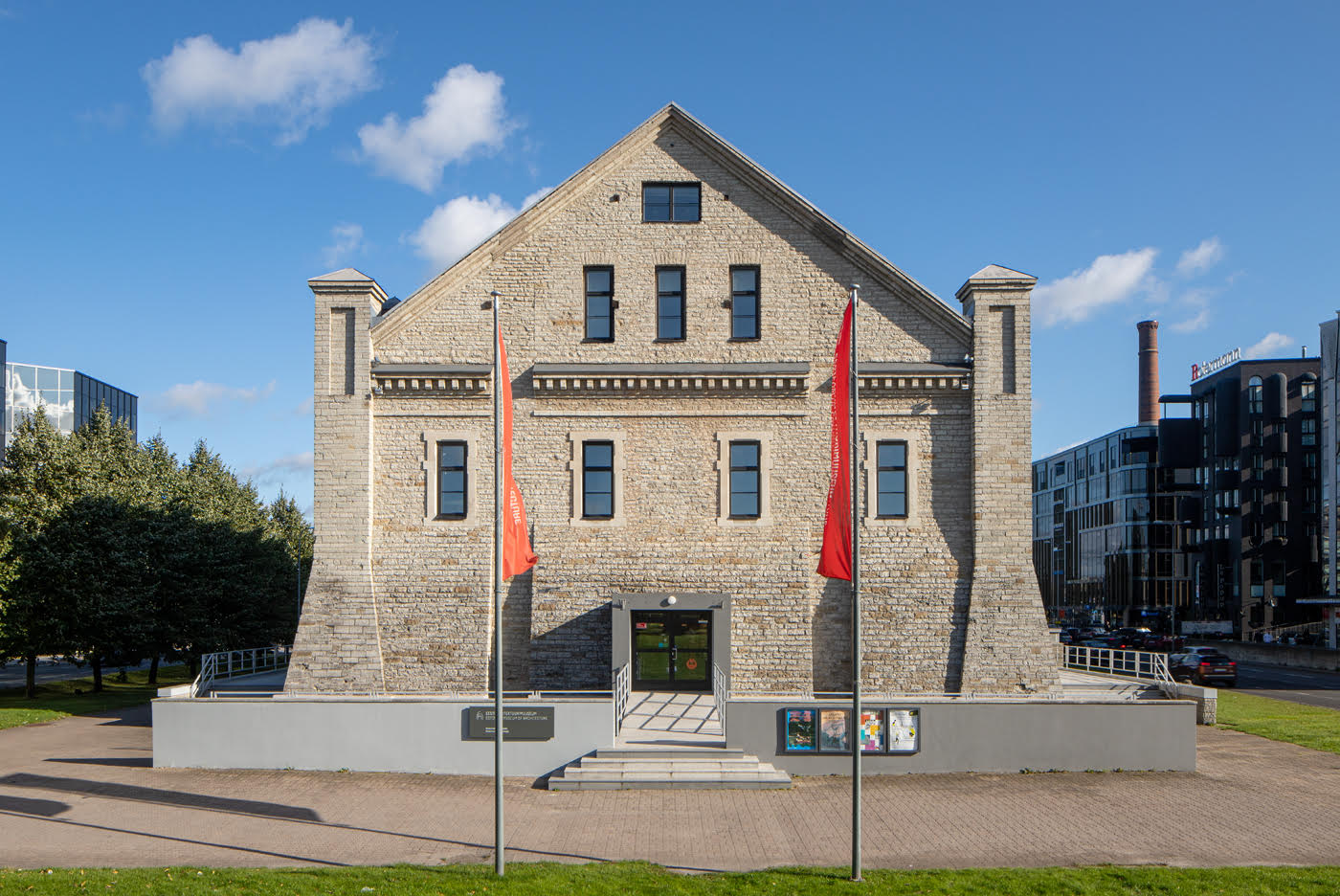-
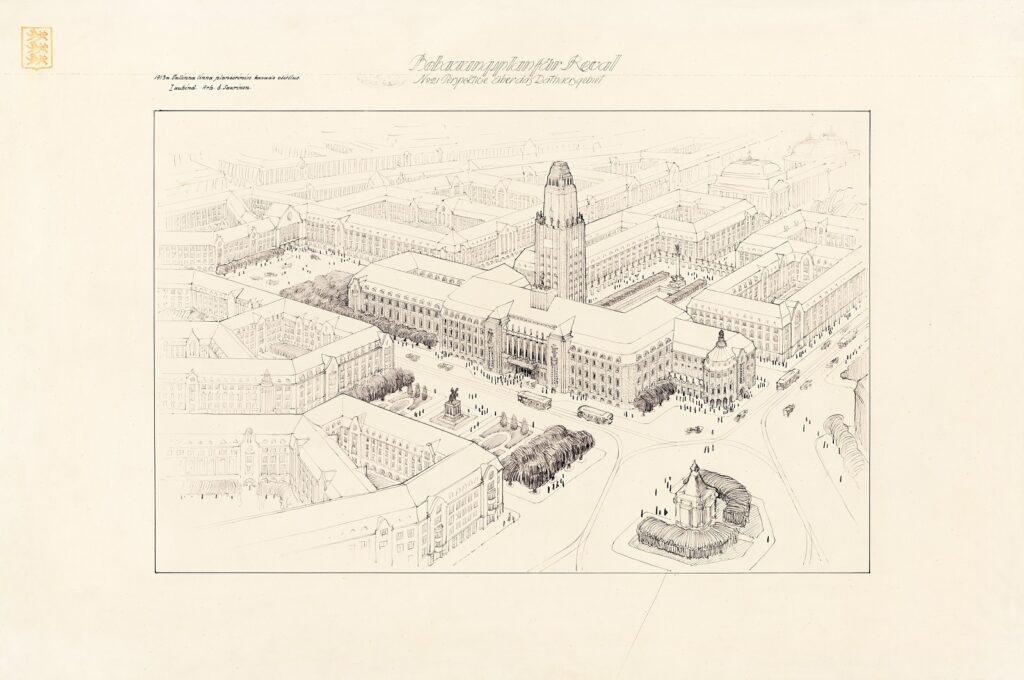
-
“Suur-Tallinn” (Greater-Tallinn) master plan, 1913. Eliel Saarinen
-

-
“Suur-Tallinn” (Greater-Tallinn) master plan, 1913. Eliel Saarinen
Eliel Saarinen, 1913. EAM 1.1.8
“Suur-Tallinn” (Greater-Tallinn) master plan
In the early 20th century, Tallinn was transforming from a sleepy provincial resort town into a modern, mid-sized European city. Rapidly developing industry and population growth resulted in the need to give consideration to the city as a comprehensive system. Finnish architect Eliel Saarinen had already worked with plans for developing Budapest, Helsinki, and Canberra. Thus, his first-place prize in the 1912–1913 competition for a general plan of Tallinn was somewhat expected. Saarinen’s entry is monumental: the city centre would be stocked with six-storey stone buildings, while worker-class neighbourhoods would be reformed with row-houses. This year is the 150th anniversary of the birth of architect Eliel Saarinen. The drawings, which belonged to the Tallinn City Government for a long time, were recently given to the museum.
Text: Sandra Mälk
Alvar Aalto, 1932. Maquette: Peet Veimer. EAM MK 47
Villa Tammekann in Tartu
February 3 is the 125th anniversary of the birth of the world-famous Finnish architect Alvar Aalto. The private residence of the University of Tartu professor August Tammekann at Kreutzwaldi st. 6 Tartu is the only completed building in Estonia designed by architect Aalto. The flat roofed, two-storey functionalist building was partially completed in 1933. According to the style’s principles, the building’s facade reflects the usage of the interior spaces. On the street side, a stairwell rises behind the vertical window, on the courtyard side, the central element is the wide ribbon window of the living room with a fireplace located at the bottom of the window. The flat roof of the house, which was not widespread at the time, caused a lot of discussion among the locals and was even considered as an anti-God phenomenon. The villa was rebuilt into an apartment building during the Soviet period. In 1994, the building was returned to Professor Tammekann’s offspring, in the 1998 University of Turku bought the building. The villa was restored according to Alvar Aalto’s project in 2000. Today, the Granö Centre of the universities of Turku and Tartu is located in the building.
The maquette of Villa Tammekann was made for the Estonian Architecture Museum exhibition “Aalto: three projects in Estonia” by Peet Veimer in 1998. Text: Anna-Liiza Izbaš
-
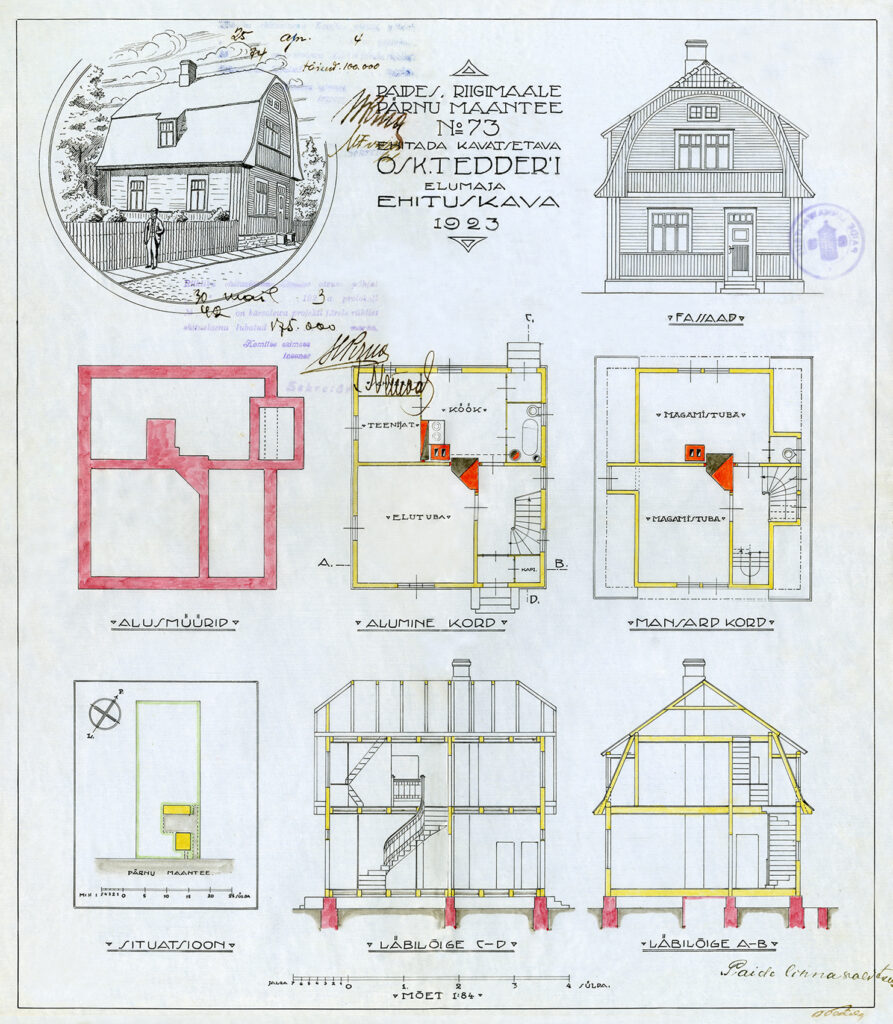
-
Residence in Paide
Residence in Paide
House in Paide
It was not overly common to commission house designs from a professional architect in the early 1920s, especially in towns and boroughs – designs were often made by building technicians and civil engineers. Compared to nowadays, the project seems unusually compact. One sheet would feature all the information about the house: views, floor plans, sections and every now and then a perspective view to please the client and show the general appearance of the future house. The house of Oskar Tedder who commissioned the project to acquire the building loan, was constructed on one of the main streets of Paide where the state handed out empty plots to establish a new garden city-like housing area. The project made in ink on the drafting cloth was added to the museum’s collection in 1992. Text: Sandra Mälk
-
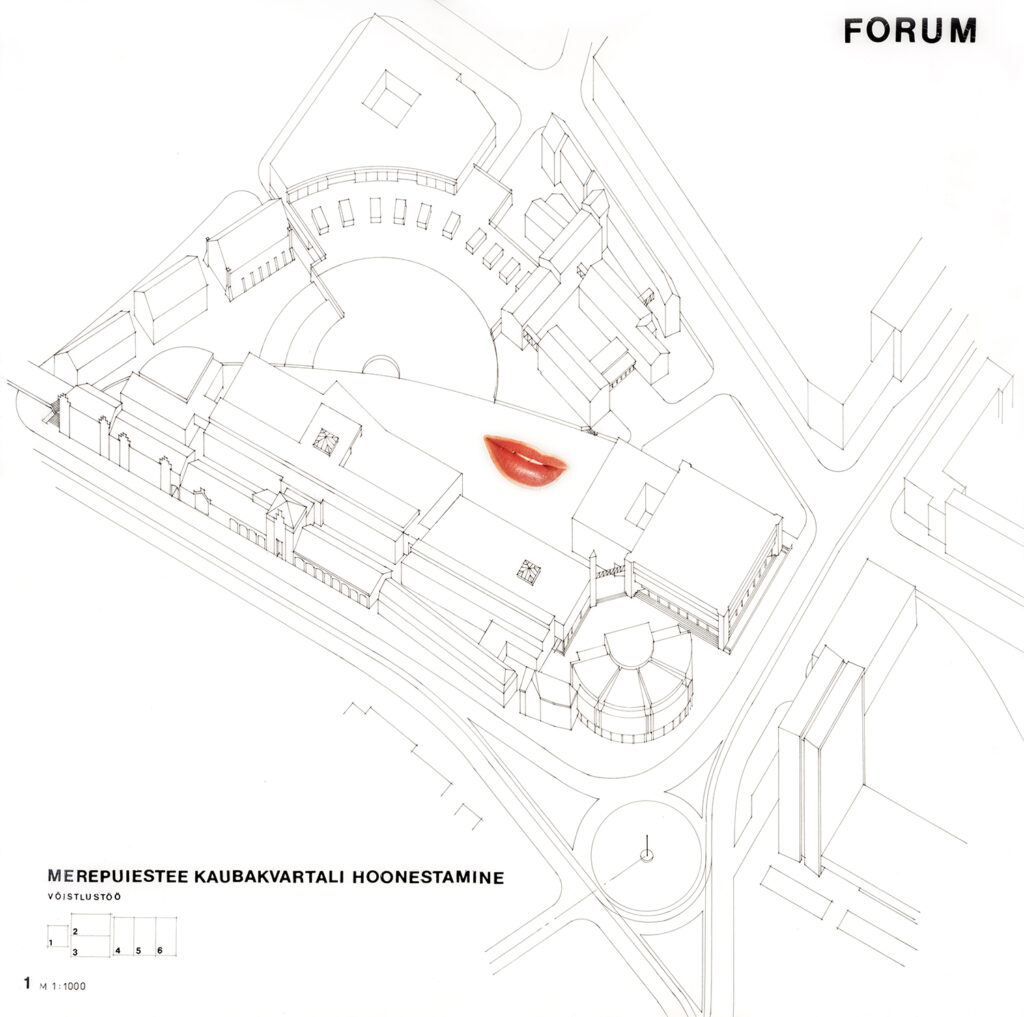
-
Shopping center in the Rotermann quarter. Competition work, 1989
Tiina Tallinn, Ell Väärtnõu, Arvi Aasmaa, engineer Rein Karilaid, 1989. EAM 5.1.21
Competition entry for the shopping centre at Mere Boulevard in Tallinn
Up until now the factory premises of the Rotermann Quarter had been closed off and an architectural competition was organised to find a way to better incorporate the area into the urban landscape. The quarter was to be the main commercial and service centre of Tallinn. The centre of the competition entry titled “Foorum” is a crescent market square – a modern interpretation of the historic forum in ancient Rome, together with all the surrounding market pavilions. The idea of market as a place of communication is further emphasised by a collage detail of lips as a means of communication. The competition entries were given to the museum in 1993 by the Tallinn City Office. Text: Sandra Mälk
-

-
Villa in Hiiumaa. Villem Tomiste, 2004
Architect Villem Tomiste, AB Kosmos 2004. Model: Paco Ulman. EAM MK 121
EMA 30 / Tiny tour of models: Villa in Hiiumaa
A futuristic-looking villa planned in the seaside village of Õngu on the west coast of Hiiumaa. The private house is characterised by an accentuated artificiality. There are no aligned walls or ceilings parallel to the floor. Variously shaped openings cut into the fractured surfaces, offer views of the surrounding unspoilt nature. The living and dining room on the second floor of the building, designed as a single flowing space, is open to the seafront reeds, with a wedge-shaped staircase leading to it from the terrace. This private house has not been built. The model was donated to the museum in 2005. Text: Anne Lass
-
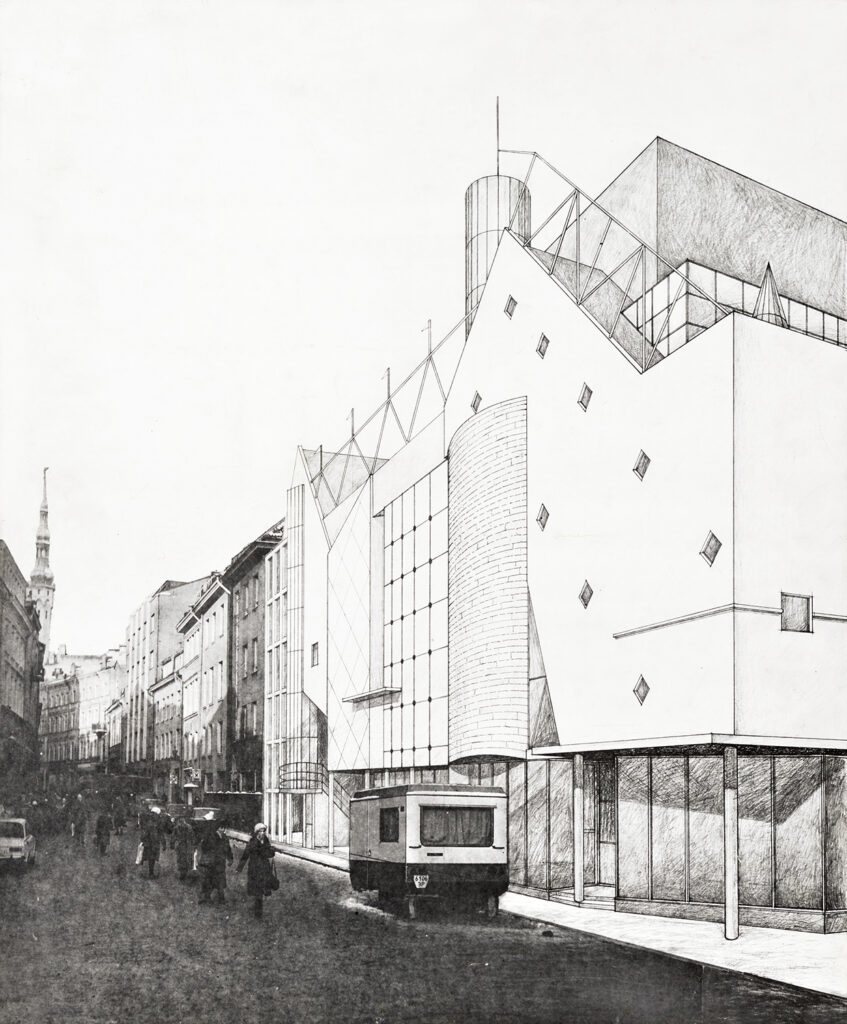
-
Vanalinnastuudio Theatre project. Vilen Künnapu, Ain Padrik, 1987
-
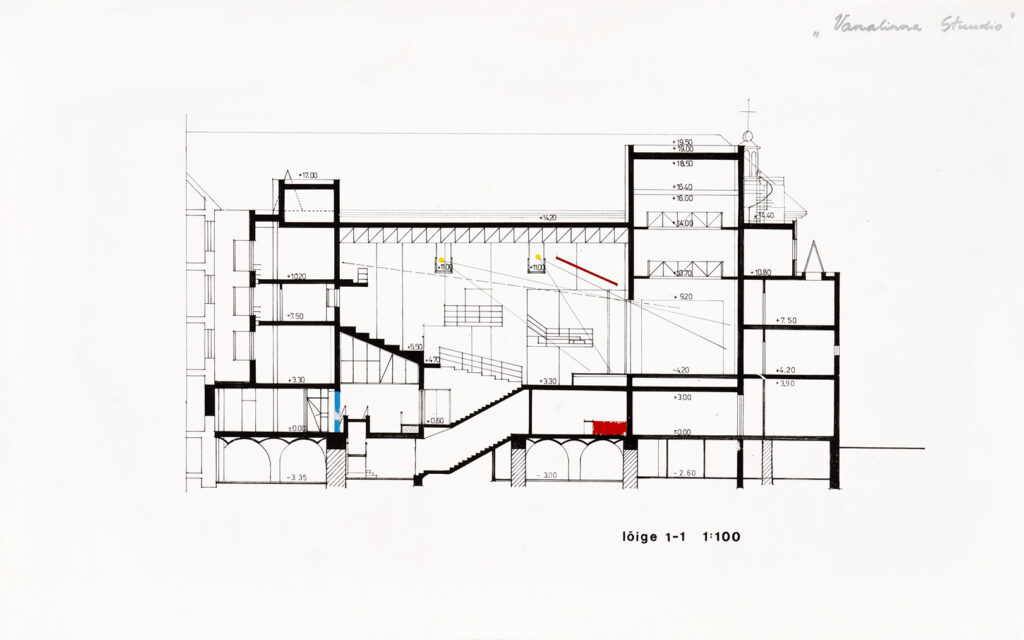
-
Building section
-

-
Vanalinnastuudio theatre building in Tallinn
Vilen Künnapu, Ain Padrik, 1987. EAM 41.1.16
Vanalinnastuudio theatre building in Tallinn
Comedy theatre Vanalinnastuudio, which started out in Tallinn Teachers’ House, became so popular under the leadership of the legendary theatre director Eino Baskin that in the mid-1980s there was an idea of building the theatre its own house in the Old Town. The beginning of Viru Street had a plot that had long been vacant (currently the De la Gardie shopping centre, 1999) and it was considered as one possible location for the building. The theatre house was designed as a black box theatre with seats for 200 people and an attic storey for lowering decorations to the stage below. The postmodernist building was never constructed under the new political regime. The display board together with the section and view was given to the museum in 2005 by architectural historian Liivi Künnapu. In addition to that, last year the architecture office Künnapu&Padrik donated their drawings and digital archive to the museum. The lot, consisting almost 200 projects, is in the final process of adding to the musem’s collection. Text: Sandra Mälk
-

-

-
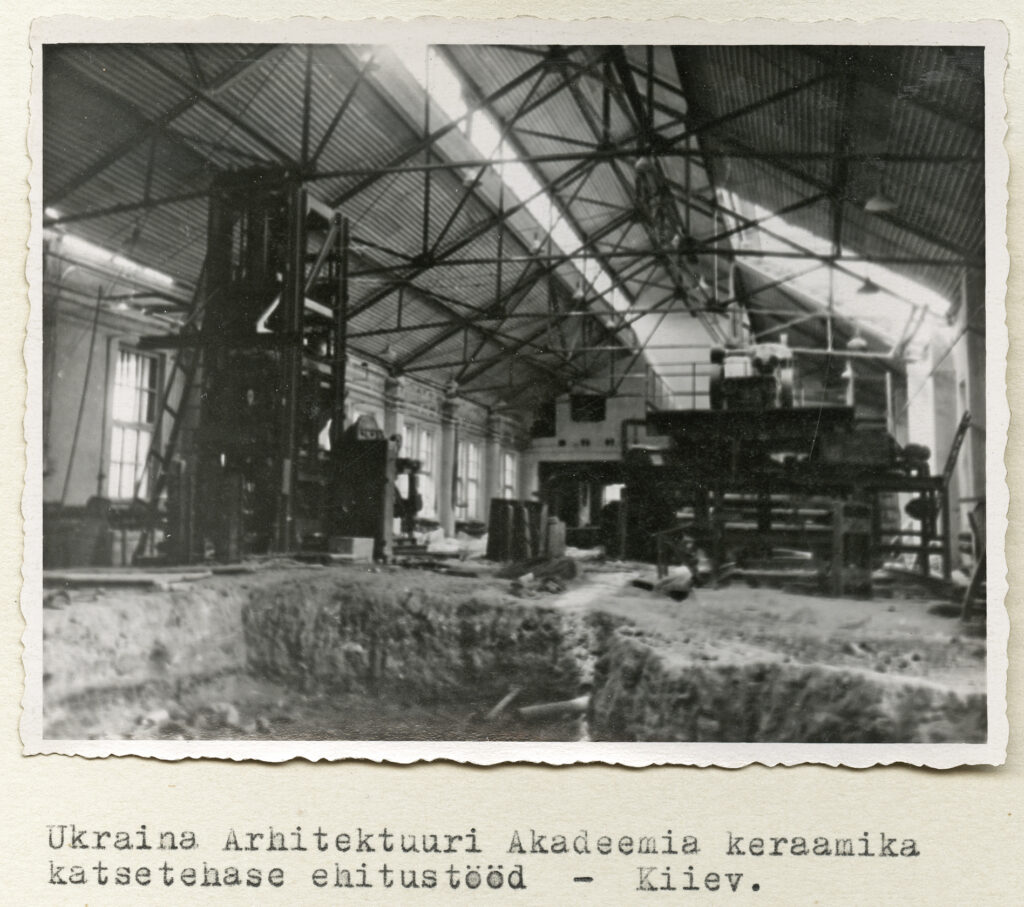
-
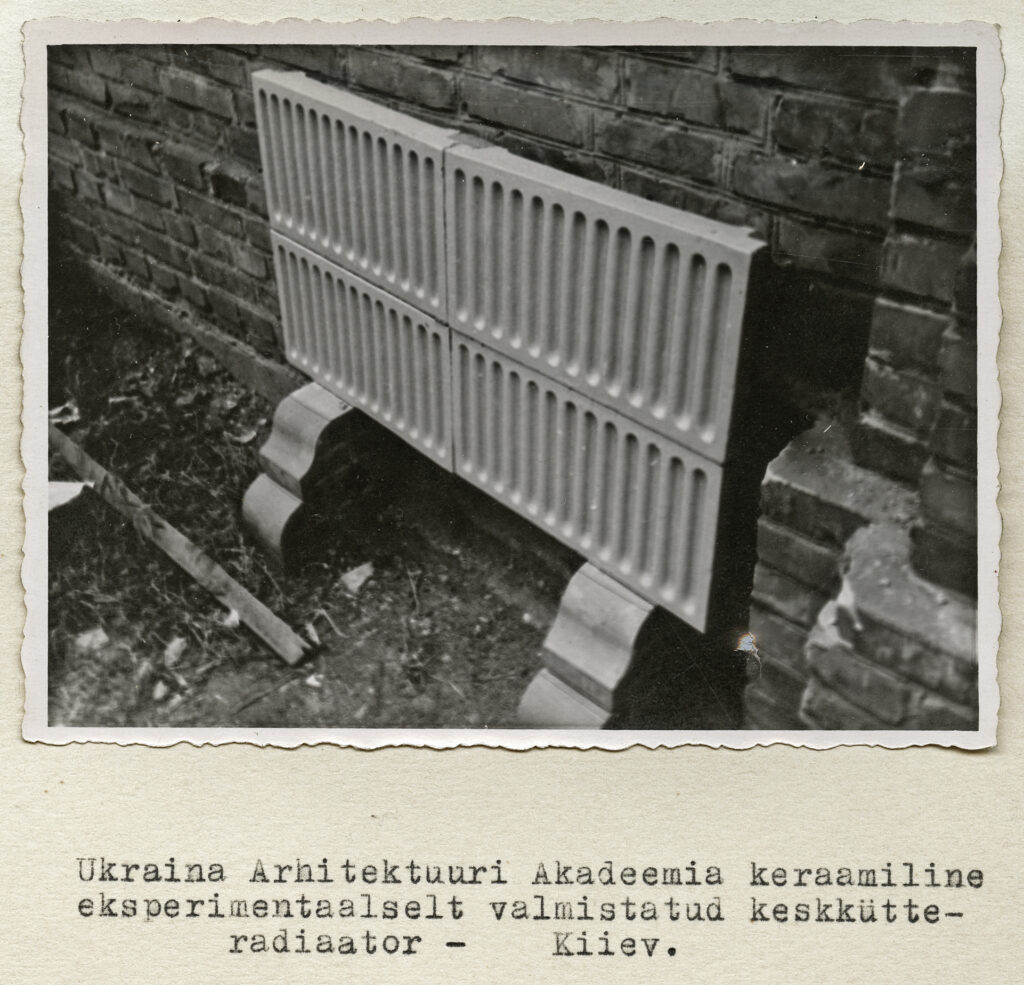
-
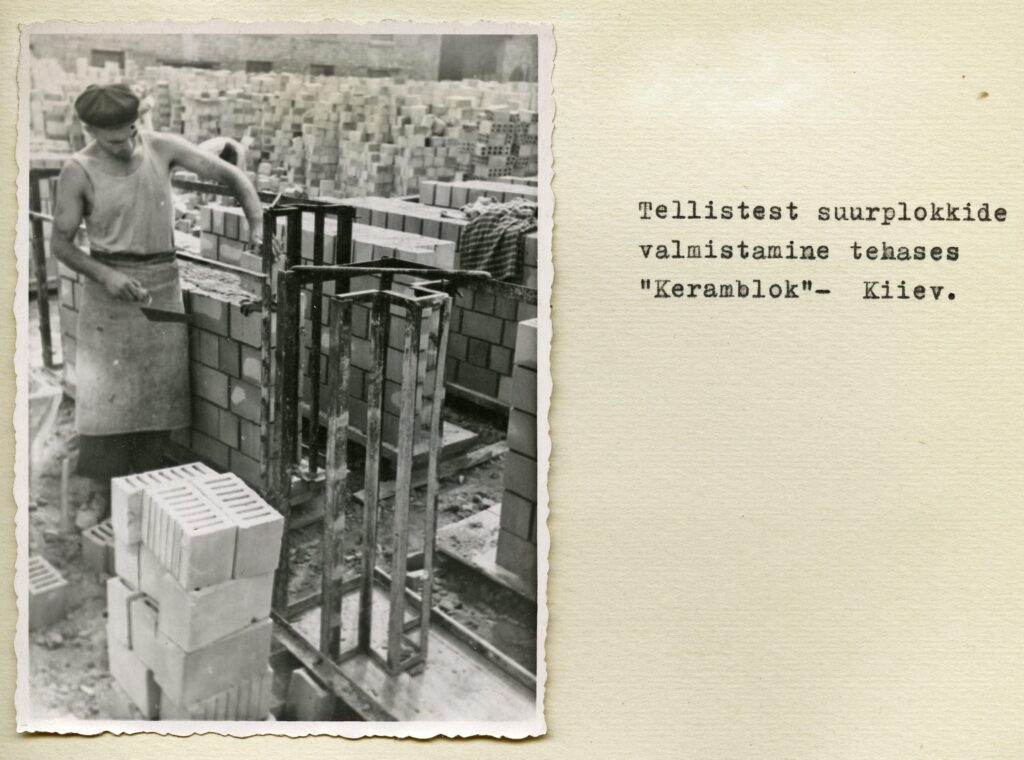
-
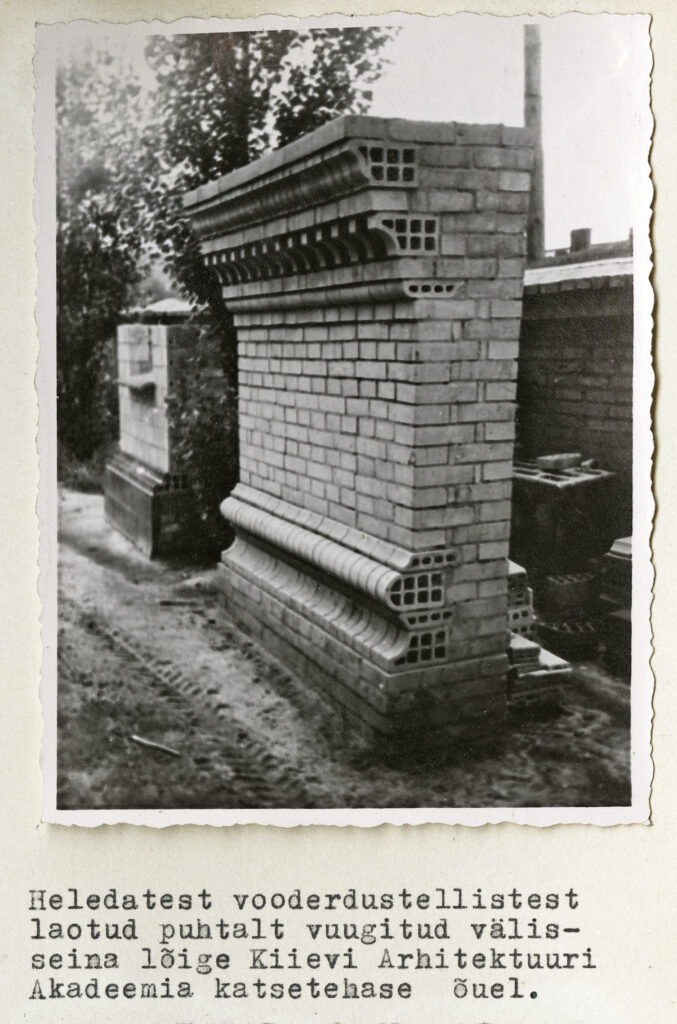
-
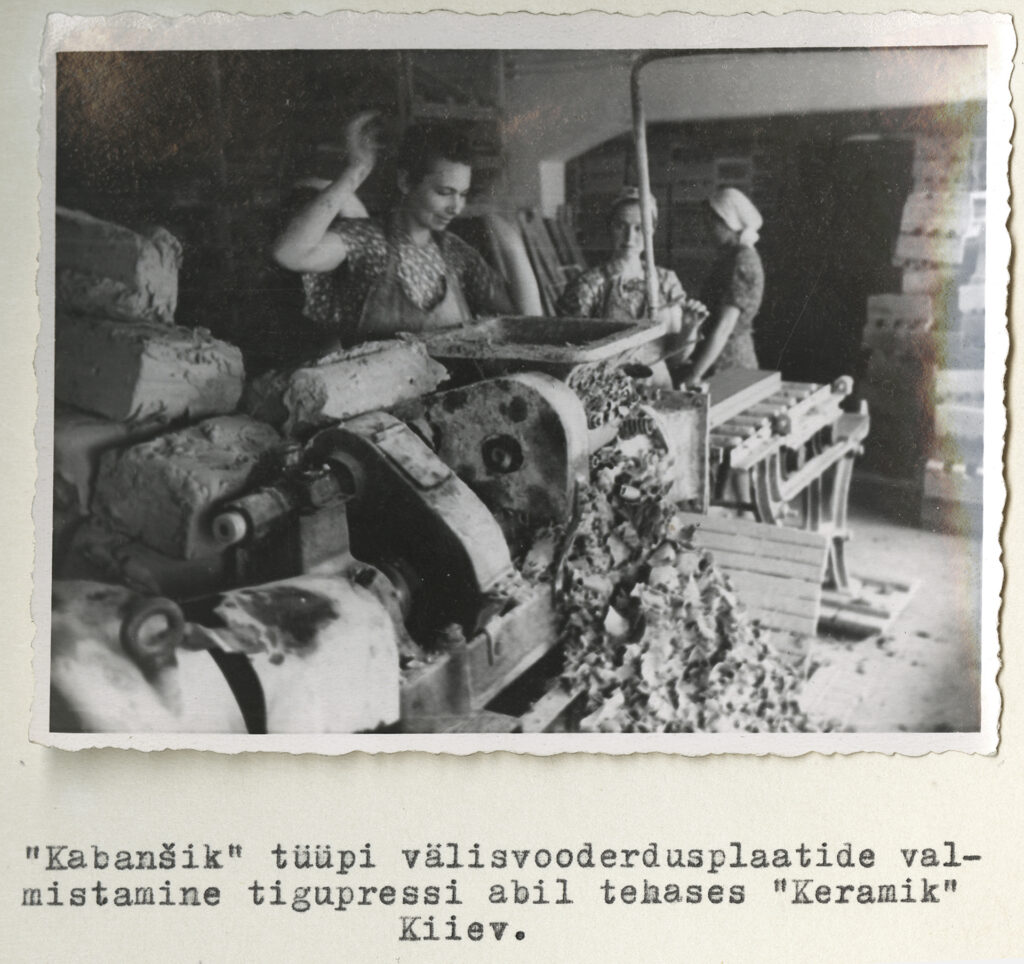
-
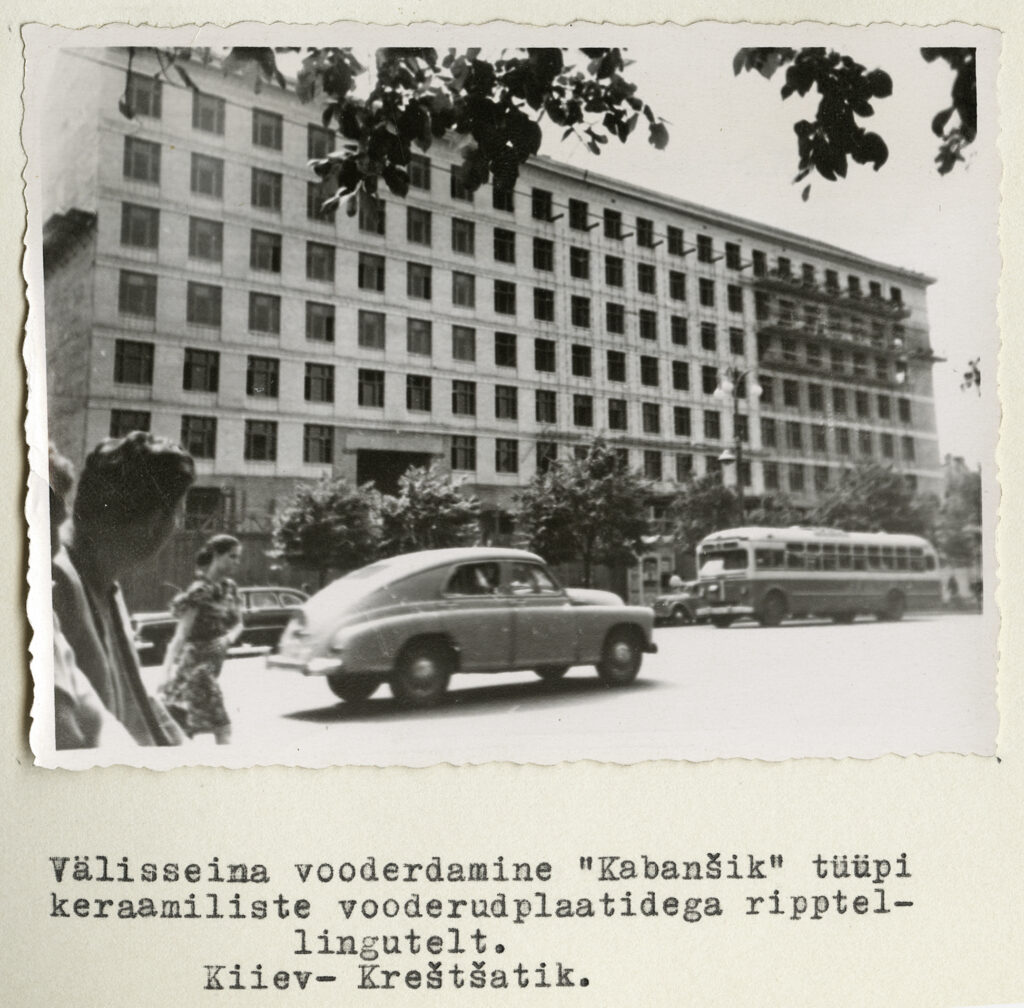
-
Installation of facade tiles along the Khreschatyk street in Kiev
Mart Port, 1956. EAM 10.4.12
Visit to the Building Ceramics’ Factories in Kyiv
The aim of Mart Port’s creative business trip (1956) was to study whether it would be possible to increase the quality and speed of industrial construction in the field of intensified mass housing construction. During the month-long trip, he passed various cities on his way from Tallinn to Ukraine and back: Riga, Kaunas, Vilnius, Lviv, Ushgorod, Kyiv. In the report of the business trip, the architect concludes that in Latvia and Lithuania, for example, the construction methods related to the construction of mass housing are quite similar here, but the tiles used for the exterior façades, which were produced in Kyiv, deserve special attention. From there he took detailed pictures for the report. He was particularly impressed by the lining of local clay tiles of the “Kabanchyk” type, developed at the Kyiv Academy of Architecture. The “kabanchyks” were light tiles, partly hollow, which were installed on the wall using small and hanging scaffoldings. The architect already knew that in Estonia it is possible to obtain the white clay needed for its production from the Joosu quarry in Võru County. During the trip, he visited the Keramik and Keramblok ceramic tile factories and the red clay mine of the latter. The Ukrainians, who have a long tradition in the clay industry and building ceramics, also introduced him to a experimental ceramics plant under construction at the Kiev Academy of Architecture, where new prototypes used in construction were completed. In the report, he pointed out that knowledge was shared bilaterally. The builders of Kyiv, Minsk, Vilnius and Riga had got acquainted with the method of covering the walls with granite plaster used in Tallinn and praised the innovativeness of this method. Text: Sandra Mälk




















